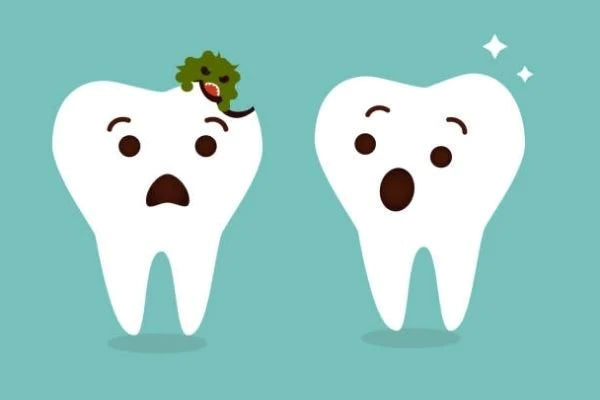Caries in children
Tooth decay is present from an early age. These dental infections are caused by sugary foods and poor oral hygiene in children. To prevent and treat them, follow this article.
What causes caries ?
Early Childhood Caries (ECC) appears well before the age of 5 and can affect the first teeth. It is usually caused by a high intake of sugar. Food particles land on the teeth after children eat or drink. They contain sugar which the decay bacteria turn into acid. During this transformation, a sticky substance (plaque) forms and affects the tooth enamel and dentin. Thus, children's tooth decay is created.
Children's tooth decay is also caused by poor dental hygiene, such as the adoption of an unsuitable brushing technique. In fact, it results dificult for children to follow the rules of tooth brushing. When children start to brush their teeth by themselves, certain tooth surfaces are not reached, such as in the areas where the permanent molars appear. These areas become the first targets for caries.
What are the symptoms of tooth decay in children?
In young children, bad breath and pain due to tooth sensitivity can indicate tooth decay. Externally, this condition can be recognised by a dark spot or white plaque on the tooth. If these signs become visible, a visit to the dentist is imperative. This is necessary to prevent caries from reaching an advanced infectious stage.
Childhood caries can also manifest itself through bleeding teeth during brushing. Cavities in a child may prevent them from eating properly, as the gums swell and become painful. So the whole mouth is paralysed. When these symptoms appear, consulting a dentist is unavoidable.
Children's oral hygiene: how to treat cavities?
In order to provide better oral health for children, the treatment of cavities must be prescribed by dentists. As a general rule, specialists should treat cavities according to their importance. In the first case, the tooth is only slightly damaged. The enamel is partially affected. The following solutions can be used to treat it.
For example, it is quite possible to remineralise the decayed tooth with fluoride varnish or to seal the grooves. The dentist can also remove the decay from the baby tooth or the permanent tooth. Alternatively, the dentist may fill the cavity with a filling, which is an alloy of mercury and an adhesive or silver composite material. This allows the teeth to be restored. For better oral hygiene in children, the administration of salivary stimulants such as chewing gums can be considered, especially in cases of asialia or hyposialia. In the worst case, treatment may include the removal of decayed baby teeth and their replacement. When the pulp of the tooth is damaged, this means that the decay has become very deep. In this context, the dentist devitalizes the tooth in order to install a crown.
Children's dental health: how to prevent cavities?
To prevent tooth decay, a combination of good oral hygiene and a low-sugar diet is necessary. In fact, certain foods rich in sugar and starch (sodas, ketchup, fruit juices, etc.) are the main food for the bacteria present in dental plaque. They add to the acids contained in the foods that children prefer and encourage the demineralisation of the enamel. It is therefore necessary to limit their ingestion in order to reduce the frequency of acid attacks. This also gives time for the enamel of baby and permanent teeth to recover. To mineralise the saliva that fights plaque, the intake of nutritional foods such as vegetables and fruit is recommended.
Impeccable oral hygiene should be adopted to prevent dental caries from an early age. In this regard, the French Union for Oral Health recommends brushing teeth. Since 2013, it has indicated that, ideally, teeth should be brushed twice a day for 2 minutes after each meal. To brush babies' first teeth (6-8 months), you should use a special toothbrush with extra soft bristles. You can also use a wet compress to clean the gums. To transport the Y-Brush toothbrush of your child more easy you can take a travel bag.It will allow you to carry all the material necessary to guarantee him an effective treatment of his caries.
As the child grows, you teach him or her to brush properly, to spit out (fluoride) toothpaste, and to use dental floss to clean the spaces between the teeth. In addition to regular brushing, an yearly visit to the dentist is necessary to check for tartar.



